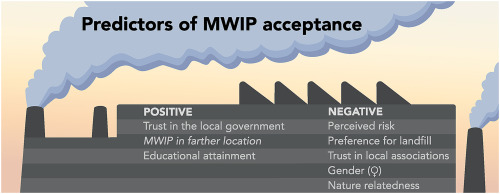当前位置:
X-MOL 学术
›
Environ. Pollut.
›
论文详情
Our official English website, www.x-mol.net, welcomes your
feedback! (Note: you will need to create a separate account there.)
Explaining social acceptance of a municipal waste incineration plant through sociodemographic and psycho-environmental variables.
Environmental Pollution ( IF 7.6 ) Pub Date : 2020-04-03 , DOI: 10.1016/j.envpol.2020.114504 Mikel Subiza-Pérez 1 , Loreto Santa Marina 2 , Amaia Irizar 1 , Mara Gallastegi 1 , Asier Anabitarte 1 , Nerea Urbieta 1 , Izaro Babarro 1 , Amaia Molinuevo 3 , Laura Vozmediano 4 , Jesús Ibarluzea 5
Environmental Pollution ( IF 7.6 ) Pub Date : 2020-04-03 , DOI: 10.1016/j.envpol.2020.114504 Mikel Subiza-Pérez 1 , Loreto Santa Marina 2 , Amaia Irizar 1 , Mara Gallastegi 1 , Asier Anabitarte 1 , Nerea Urbieta 1 , Izaro Babarro 1 , Amaia Molinuevo 3 , Laura Vozmediano 4 , Jesús Ibarluzea 5
Affiliation

|
Municipal waste incineration plants (MWIPs) are a source of emission of diverse pollutants that have been associated with environmental and health effects, mainly in relation to premises that are old and not well equipped or maintained. As a result, the public usually holds a negative view of such plants and tends to react adversely to construction of new plants. Understanding a population's perceptions is key to ensuring the correct development of such infrastructure and adequately managing population health concerns and behaviours. In this study, we surveyed 173 residents living close (≤ 10 km) to an MWIP being built in San Sebastian (Gipuzkoa, Spain) and 164 living further away (>10 km). The questionnaire included sociodemographic and psycho-environmental measures. Answers to the questionnaire revealed a fairly low acceptance rate and the perception of a high risk for human health and the environment (average scores of 0.57, 3.07 and 2.89 respectively in a 0 to 4 scale), with no statistically significant differences between people living nearby and further afield. A hierarchical regression model built to explore the public's acceptance of the MWIP explained 59% of the variance. Dominance and relative weight analyses revealed that the most important predictors of acceptance were trust in the information provided by the local government and perceived risk for human health, which accounted for 33.7% and 27.4% of the variance explained by the model respectively. Preference for landfilling and MWIP acceptance in a farther location made a less relevant contribution.
中文翻译:

通过社会人口统计学和心理环境变量解释对城市垃圾焚烧厂的社会认可度。
市政垃圾焚烧厂(MWIP)是各种污染物的排放源,这些污染物与环境和健康影响有关,主要涉及旧的,设施不完善或维护不佳的房屋。结果,公众通常对这种植物持负面看法,并且倾向于对新植物的建造做出不利反应。理解人口的观念是确保此类基础设施正确发展并适当管理人口健康问题和行为的关键。在这项研究中,我们调查了居住在San Sebastian(西班牙吉普斯夸省)附近的MWIP附近的173名居民(≤10 km),以及更远处(> 10 km)的164名居民。问卷包括社会人口统计学和心理环境措施。对问卷的回答表明接受率相当低,并且对人类健康和环境具有高风险的感知(0到4等级的平均得分分别为0.57、3.07和2.89),附近居住的人之间没有统计学上的显着差异还有更远的地方。建立用来探索公众对MWIP接受程度的分层回归模型可以解释59%的差异。优势度和相对权重分析表明,接受的最重要预测因素是对当地政府提供的信息的信任以及对人类健康的感知风险,分别占模型解释的方差的33.7%和27.4%。偏爱填埋和在更远的地方接受MWIP的贡献较小。
更新日期:2020-04-03
中文翻译:

通过社会人口统计学和心理环境变量解释对城市垃圾焚烧厂的社会认可度。
市政垃圾焚烧厂(MWIP)是各种污染物的排放源,这些污染物与环境和健康影响有关,主要涉及旧的,设施不完善或维护不佳的房屋。结果,公众通常对这种植物持负面看法,并且倾向于对新植物的建造做出不利反应。理解人口的观念是确保此类基础设施正确发展并适当管理人口健康问题和行为的关键。在这项研究中,我们调查了居住在San Sebastian(西班牙吉普斯夸省)附近的MWIP附近的173名居民(≤10 km),以及更远处(> 10 km)的164名居民。问卷包括社会人口统计学和心理环境措施。对问卷的回答表明接受率相当低,并且对人类健康和环境具有高风险的感知(0到4等级的平均得分分别为0.57、3.07和2.89),附近居住的人之间没有统计学上的显着差异还有更远的地方。建立用来探索公众对MWIP接受程度的分层回归模型可以解释59%的差异。优势度和相对权重分析表明,接受的最重要预测因素是对当地政府提供的信息的信任以及对人类健康的感知风险,分别占模型解释的方差的33.7%和27.4%。偏爱填埋和在更远的地方接受MWIP的贡献较小。











































 京公网安备 11010802027423号
京公网安备 11010802027423号